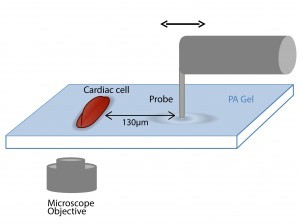Mechanical Stimulation of Cardiac Cells Could Make Better Pacemakers
Discovered importance of mechanical communication could drive development of new therapies for cardiovascular diseases

In a breakthrough that could change the future of pacemakers, Technion-Israel Institute of Technology researchers have used mechanical stimulation to “train” cardiac cells to beat at a given rate.
The team’s findings, published this week in Nature Physics, also demonstrate for the first time that direct physical contact with the cardiac cells is not required to synchronize their beating.
As long as the cardiac cells are in the tissue being mechanically stimulated, they are trained by the stimulation, with long-lasting effects that persist even after it is stopped.
“Cell-cell communication is essential for growth, development and function,” explains, Assistant Professor Shelly Tzlil, of the Technion Faculty of Mechanical Engineering.
“We have shown that cells are able to communicate with each other mechanically by responding to deformations created by their neighbors. The range of mechanical communication is greater than that of electrical and chemical interactions. Another significant discovery is that the duration of cell pacing is greater when the stimulus is mechanical, indicating that mechanical communication induces long-term alterations
The stimulation was applied by an artificial “mechanical cell,” consisting of a tiny probe (with a 0.0025 cm tip diameter) that generated (via cyclical indenting and pulling) periodic deformations in the underlying substrate (cardiac tissue). The deformations mimicked those generated by a beating cardiac cell that was also in the tissue. After a brief 10-minute training period, the cardiac cell synchronized its beating rate with the mechanical cell. Furthermore, the cardiac cell maintained the induced beating rate for more than one hour after mechanical stimulation was stopped.
“In this study, we show that an isolated cardiac cell can be trained to beat at a given frequency by mechanically stimulating the underlying substrate,” says Tzlil. “Mechanical communication plays an important role in cardiac physiology, and is essential for converting electrical pacing into synchronized beating. Impaired mechanical communication will lead to arrhythmias even when electrical conduction is working properly. The medical implication is that adding mechanical elements to electrical pacemakers will significantly improve their efficiency.”
Synchronized beating of mechanically-coupled cardiac cells: time-lapse imaging of a pair of beating cardiac cells on a 3.8kPa substrate. Phase contrast (left) and calcium imaging (right). The scale bar is 20 microns.
Pair of cells: Mechanical deformations generated in the substrate by synchronized beating of mechanically coupled cardiac cells: Time-lapse imaging of the deformation field generated by a pair of beating cardiac cells on a 3.8kPa substrate. Mechanical deformations are detected by following movements of fluorescent beads embedded in the gel.
